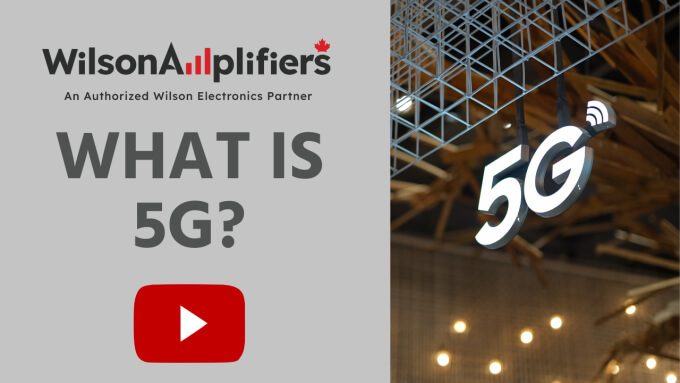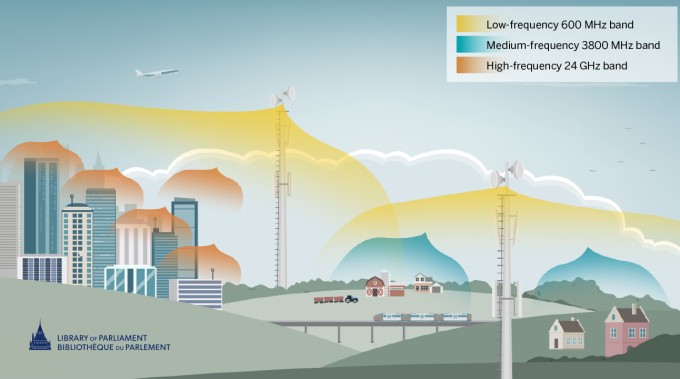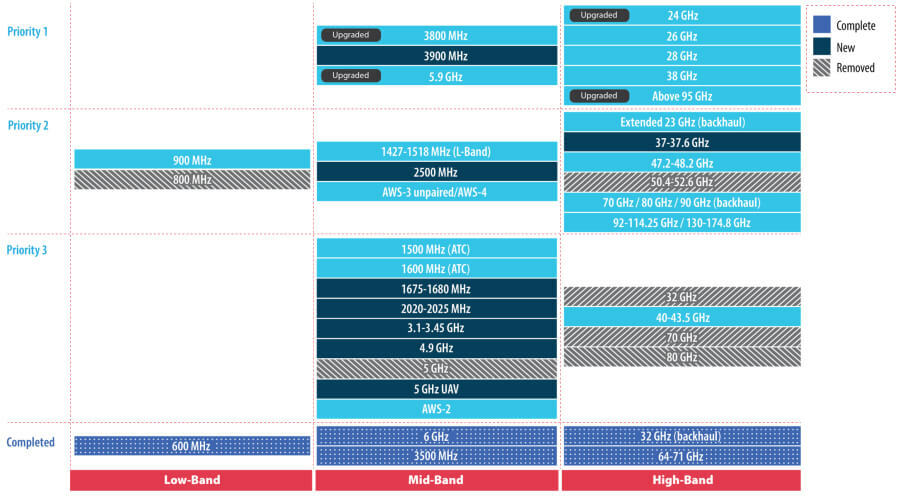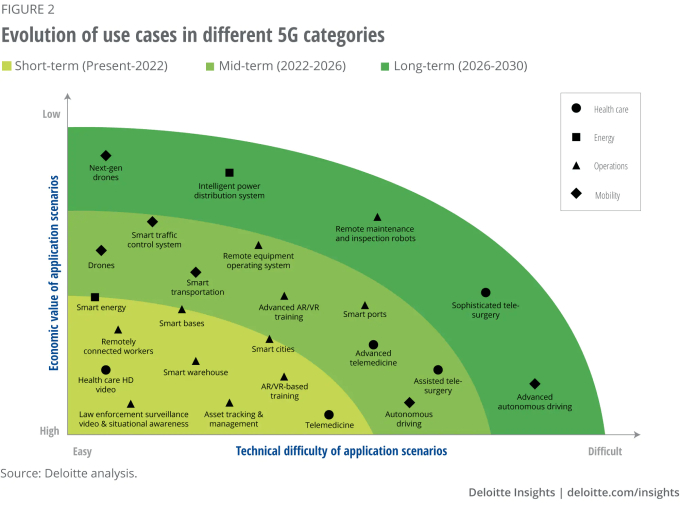What Is 5G & Frequency Bands?
What is 5G?
5G is the fifth-generation technology for cellular networks, successor to 4G. It promises to deliver blazing-fast speeds, low latency, massive capacity, and greater reliability.
The capabilities of such a network go far beyond cell phone connectivity. It will expand the Internet of Things (IoT) ecosystem and transform tons of industries. To cater to different applications, 5G operates across a wider set of frequency bands.

We fix poor cell phone signal! Find the right signal booster for you:




Is 5G Better than 4G LTE?
Short answer, yes. Compared to 4G, it offers much faster data speeds, significantly less latency, and has the ability to connect more devices simultaneously.
In the early stages, it might not seem like it. However, as the technology becomes available in more places and evolves, it will be noticeable.
What are 5G Frequency Bands?
5G devices and 5G towers or small cells communicate wirelessly via radio waves. These radio waves are tuned to specific frequencies allocated for 5G use.
Frequency bands are made up of a range of frequencies. Cellular carriers own sections of different bands to build their 5G network. Speed and range of 5G cellular signals vary depending on where they fall within the frequency spectrum.
What Frequencies Does 5G Use?
 Image Source: Hillnotes.ca
Image Source: Hillnotes.ca
The radio spectrum ranges from 3 kHz to 300 GHz. Multiple frequencies are needed to deploy 5G. It operates on three sections of the spectrum: low-band, mid-band, and high-band (mmWave).
Low-Band 5G
Low-Band 5G represents frequencies below 1 GHz. Currently, in Canada, Low-Band 5G operates on the 600 MHz band, which covers 614-698 MHz. Within the next few years, more low-band spectrum will be made available. The ISED has suggested in the Outlook Consultation that the 800 MHz and 900 MHz bands should be reviewed for 5G use.
Being on the lower end of the spectrum, these frequencies can travel long distances and aren't as easily affected by obstacles. Thus, they’ll play a huge role in delivering next-generation wireless connectivity to those in outlying suburban and rural areas. Speed, however, will be pretty similar to 4G.
Mid-Band 5G
Mid-Band 5G is thought of as the “just right” band. Operating between 1 GHz to 10 GHz, it offers the perfect blend of speed, coverage, and capacity. The 3.5 GHz (launched in 2022) and 3.8 GHz (acquired in 2023) bands are viewed as key spectrums for 5G technology by the ISED. Mid-band is ideal for suburban and urban environments where demand is consistently high.
Most Canadian carriers are using the 1.7/2.1 GHz and the 3.5 GHz bands for their mid-band 5G service. Rogers is currently the only cellular provider using the 2.5 GHz band. The ISED has plans to release more mid-band spectrum within the next few years.
High-Band 5G or mmWave 5G
The high-band spectrum refers to frequencies above 10 GHz. High-Band or mmWave 5G, not yet available in Canada, will operate between 25-39 GHz.
In 2022, the Government of Canada launched consultation for mmWave spectrum in the 26, 28, and 38 GHz bands.
This is where users will experience those blazing fast speeds and ultra-low latency 5G promises. However, the tradeoff is range.
mmWaves can only travel short distances and have a difficult time penetrating buildings. The waves are easily disrupted. To relay these signals inside buildings, it's likely special antennas and equipment will be needed.
This spectrum is best for densely populated urban areas and busy venues. Featuring higher capacity, the network will be able to handle more devices at a time. Unreliable connectivity due to high traffic will be significantly mitigated.
mmWave spectrum will be auctioned in 2024.
How Do I Connect to Different 5G Bands?
5G devices are programmed to automatically pick up 5G signals. Though, there are a few requirements that must be met to access the 5G network. They include being in a 5G area, using a 5G device, and having a 5G plan. For more information, visit “How to Get 5G”.
What is 5G and 5G+?
Bell, Roger, and Telus all advertise 5G and 5G+ networks. 5G+ typically refers to an enhanced version of 5G technology that offers faster speeds and improved capabilities.
When connected to 5G+, you are likely on to the 3.5 GHz spectrum. Standard 5G, on the other hand, connects you to the 600 MHz and 1.7/2.1 GHz bands.
What is the Best Frequency for 5G?
Truth be told, there is no “BEST” frequency band. All bands cater to different demands. Low-Band 5G offers the most coverage, High-Band 5G will provide the best speeds, and Mid-Band 5G excels at both.
Which 5G Band Is Fastest?
Higher frequencies provide faster data transmissions. By far, mmWave 5G band will deliver the fastest speeds. Under optimal conditions, this spectrum will deliver minimal speeds of 1 Gbps.
What 5G Frequencies Does Each Carrier Use?
Not all cellular carriers use the same 5G frequency bands. They purchase licenses for exclusive rights to specific frequencies that align with their goals.
| Carriers: | Low-Band 5G Freq: | Mid-Band 5G Freq: | High-Band 5G Freq: |
| Bell Mobility | Did Not Acquire 600 MHz Spectrum | 1.7/2.1 GHz: Band 66 3.5 GHz: Band n78 3.8 GHz: To Be Deployed |
TBD |
| Rogers | 600 MHz: Band n71 | 1.7/2.1 GHz: Band 66 2.5 GHz: Band n41 3.5 GHz: Band n78 3.8 GHz: To Be Deployed |
TBD |
| Telus Mobility | 600 MHz: Band n71 | 1.7/2.1 GHz: Band 66 3.5 GHz: Band n78 3.8 GHz: To Be Deployed |
TBD |
*This table is subject to change, as more frequencies are auctioned off for use.
Future 5G Frequency Deployments
The following image, developed by the ISED, illustrates future 5G frequencies and their priority. The timeline of each frequency's deployment is not available.
 Image Source: ISED Spectrum Outlook 2023-2027
Image Source: ISED Spectrum Outlook 2023-2027
Who Has Access to the Widest 5G RF Spectrum?
Rogers has the most 5G spectrum allowing it to offer extensive 5G coverage in the places people live, work, and travel. However, according to Opensignal’s 2024 5G Experience Report, Bell offers the fastest 5G speeds.
Why are 5G Bands Important?
Every year the number of cellular-connected devices increases. This includes smartphones, security systems, cellular routers, and other cellular IoT units.
Previous generation cellular frequencies could only support so many devices at a time. During congestion, speed and reliability drastically decrease. Eventually, capacity runs out.
The fifth-generation network allows more devices to use data faster and more efficiently. Using different bands isn’t just about a hulked-out cellular network. It opens the door for new use cases, such as smart cities, autonomous vehicles, digital health, drones, and much more. To deliver on the 5G promise, carriers must use a mix of frequencies to cater to different data demands.
In rural environments with sparse cell towers, coverage is more important to reach as many devices as possible. This is where Low-Band 5G will make a big impact. Data demand and traffic increase in the suburbs and cities. More capacity and speed are needed to keep devices connected. That’s what Mid-Band 5G and High-Band 5G will do.
How to Get Better 5G Signals Indoors?
Your environment and building material can impact indoor 5G coverage. Currently, there is no perfect way to improve 5G coverage in homes and offices. Though, the best option available is a 5G-ready cell phone signal booster. It uses:
- An external antenna to capture existing 5G signals (on supported bands)
- Coaxial cable to bypass building materials
- An amplifier to enhance the signal
- An indoor antenna to rebroadcast the boosted signal indoors
Signal boosters only work with certain frequencies. The most common are 700 MHz, 850 MHz, 1700/2100 MHz, and 1900 MHz. The booster will only support 5G signals deployed on those bands.
As 5G evolves and technology adapts, more options will become available.
Our weBoost and WilsonPro signal boosters are 5G ready and work with all cellular providers.
Wilson Amplifiers is the leading provider of home, office, and vehicle signal boosters. If you have any questions or need help finding a booster, we can help. Call (1-800-373-2927), email (sales@wilsonamplifiers.ca), or chat with us. You can also find more information on our signal boosters FAQ page.
Sources:
- What is 5G | ISED
- Spectrum Outlook 2023-2027 | ISED
- Bell Announces 5G+ Service on Mid-Band Spectrum | ITWorldCanada
- Rogers Launches Faster 5G Service on 3500MHz Mid-Band Spectrum | ITWorldCanada
- Rogers Doubles the Size of Canada’s First and Largest 5G Network | Rogers
- 3800 MHz Band Auction | ISED
- TELUS Secures New 600 MHz Spectrum Licenses | Telus
- TELUS Deploys 3500 MHz 5G Spectrum | Telus
- Bell Update on Federal Auction of 600 MHz Spectrum | Newswire


Money Back Guarantee

Technical Support
